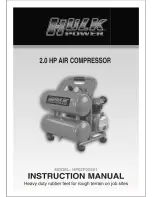
BREAK-IN PROCEDURES & OPERATION
LOC
A
TION O
F
TH
E
AI
R
COMPRESSOR
ADDITIONA
L
REGUL
A
TORS AND CONTROLS
Since the air tank pressure is usually greater than that which is needed, a regulator is employed to control the air pressure ahead of any
individual driven device. Separate air transformers which combine the function of air regulation, moisture and dirt removal should be used where
applicable.
BREAK-IN PROCEDURES
NOTE: SERIOUS DAMAGE M
AY
RESU
L
T IF THE FOLLOWING BREAK-IN INSTRUCTIONS
ARE
NOT CLOSE
LY
FOLLOWED. THIS
PROCEDURE IS REQUIRED BEFORE THE AIR COMPRESSOR CAN
BE
PUT INTO SE
R
VICE, AFTER REPLACING THE CHECK
VAL
VE,
AND WHEN THE PISTON OR THE CYLINDER SLEEVE IS REPLACED.
A. Fill crankcase with oil as described in “Changing Oil” in the maintenance section on the following page.
B. Set the pressure switch lever to the “OFF” position.
C. Plug the power cord into the correct 110V branch circuit receptacle.
D. Fully open the drain valve (A) Fig. 4, by turning it counterclockwise, to prevent air pressure
build-up
in the tank.
E. Move the pressure switch lever to “ON/AUTO”. The compressor will start.
F. Run the compressor for 15 minutes. Make sure the drain valve is open and there is no tank pressure
build-up
by watching the tank pressure
gauge.
G. After 15 minutes, close the drain valve by turning clockwise. The air receiver will fill to
“Cut-Out”
pressure and the motor will stop. The
compressor is now ready for use.
OPER
A
TIN
G
PROCEDURES
Preparation for use:
1. Before attaching an air hose or accessories, make sure the OFF/AUTO lever is set to “OFF” and the air regulator is closed. Once this is done,
you can now attach a hose or an accessory.
WARNING
: Too much air pressure causes a hazardous risk of bursting. Check the manufacturer's maximum pressure rating for air tools and
accessories. The regulator outlet pressure must never exceed the maximum pressure rating of the tool being used.
3. Turn the “ON/AUT
O-OFF”
lever to “ON/AUTO” and allow tank pressure to build. Motor will stop when tank pressure reaches
“Cut-Out”
pressure.
4. Open the regulator by turning it clockwise. Adjust the regulator to the correct pressure setting. The compressor is ready for use.
5. Always operate the air compressor in well ventilated areas; free of gasoline or other solvent vapors. Do not operate the compressor near the
spray area.
After Use:
6. Set the “ON/AUT
O-OFF”
lever to “OFF”.
7. Turn the regulator counterclockwise to set the outlet pressure to zero.
8. Disconnect the air tool or accessory.
9. Pull ring on safety valve (B) Fig. 4, allowing air to bleed from the tank until tank pressure is approximately 20 psi. Release safety valve ring.
10. Drain water from air tank. Turn drain valve (A) Fig. 4, counterclockwise to open.
WARNING!: W
A
TER WIL
L
CONDENSE IN THE AIR TANK. IF NOT DRAINED REGULAR
LY
, W
A
TER WIL
L
CORRODE AND WEAKEN THE
AIR TANK CAUSING
A
RISK OF AIR TANK RUPTURE.
NOTE: If drain valve is plugged, pull ring on safety valve (B) Fig. 4, and hold until air pressure has been released. The valve can then be removed,
cleaned, and reinstalled.
11. After the water has been completely drained, turn drain valve to close. The air compressor can now be stored.
6
Your compressor comes almost completely assembled. Only the air filter needs to be installed. Operate the air compressor in a dry, clean,
cool, well ventilated area. The air compressor pump and case are designed to allow for proper cooling. Clean or blow off dust or dirt that
collects on the air compressor. A clean air compressor runs cooler and provides longer service. The ventilation openings on your air compressor
are necessary to maintain proper operating temperature. Do not place rags or other containers on or near these openings.
Содержание HP02P005S1
Страница 1: ......
Страница 9: ...PARTS DIAGRAM MODEL HP02P005S1 8...
Страница 11: ...937 540 1157...





























